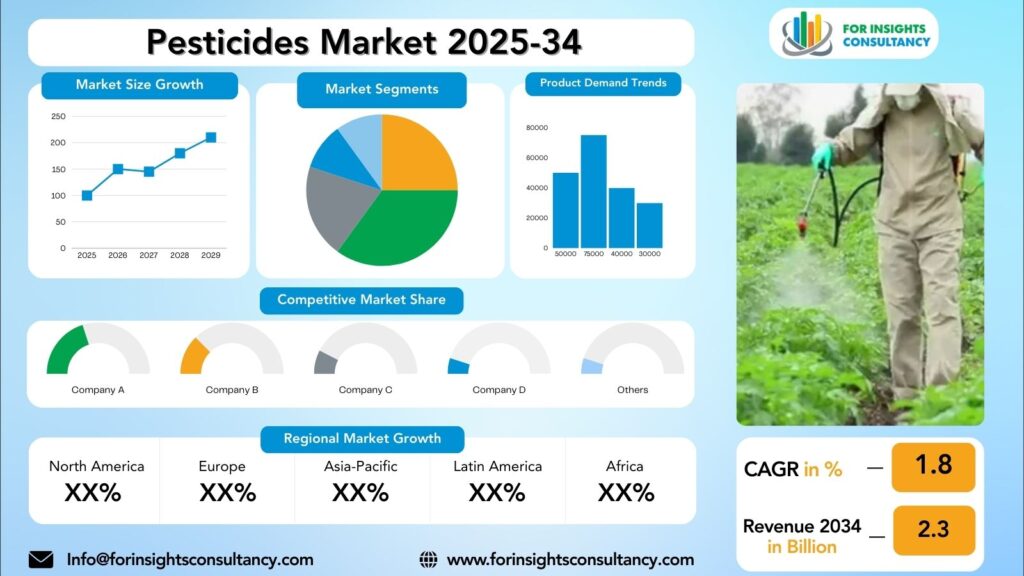
Pesticides Market Research Report By Product Type (Herbicides,Insecticides, Fungicides), By Crop Type (Grains & Cereals, Fruits & Vegetables, Pulses & Oilseeds, Commercial Crops, Turf & Ornamental), by Formulation (Liquid, Dry), by Origin, and Region Global Market Analysis and Forecast, 2025-2034
Aug-2025 Formats | PDF | Category: Agriculture | Delivery: 24 to 72 Hours
Pesticides Market is forecast to increase from USD 1.4 Billion in 2025 to USD 2.3 billion by 2034, at a CAGR of 1.8%.
Pesticides Market: A Comprehensive Overview and Future Developments
The global pesticides market is a vital sector in modern agriculture, primarily dominated by chemical pesticides. However, there is a growing trend towards biopesticides, which are considered more environmentally friendly. The market is also undergoing a shift towards sustainable agriculture practices, with consumers becoming more aware of the environmental impact of pesticides. This has led to the development of innovative products that are more targeted and less harmful to beneficial insects and wildlife.
The future of the pesticides market is likely to be shaped by advancements in technology and regulatory changes. With growing concerns about the environmental impact of pesticides, regulators are imposing stricter guidelines, leading to the development of safer, eco-friendly products. Precision agriculture, which uses data and technology to optimize pesticide use, is another key development. This approach allows farmers to target specific areas of the field that require treatment, reducing waste and minimizing environmental impact. Overall, the pesticides market is expected to continue growing due to the increasing demand for food and the growing population.
Pesticides Market Dynamics
Growth Drivers
The pesticides market is experiencing growth due to technological advancements in agricultural technology, the adoption of Integrated Pest Management (IPM) practices, and the growing global population and food demand. Innovative pesticide formulations like biopesticides and synthetic pesticides are gaining traction among farmers, aiming to combat pests while minimizing environmental impact. The growing awareness of the environmental and health risks associated with conventional pesticide use has led to a surge in the adoption of IPM practices, which combine biological, cultural, and chemical control methods. The escalating demand for agricultural products is driving the growth of the pesticides market globally. Government initiatives supporting sustainable agriculture are also driving the growth of the pesticides market, offering subsidies, incentives, and regulations to encourage eco-friendly pesticide use and sustainable farming methods.
Restraints
The pesticides market is a rapidly growing sector that aims to protect crops from pests and diseases. However, it faces several challenges, including increasing environmental concerns, stricter regulations and compliance requirements, and resistance management. Environmental concerns include the negative impacts of pesticides on the environment, such as water pollution and harm to non-target species. Regulations and compliance requirements are being implemented by governments worldwide, leading to increased costs for companies and decreased availability of certain active ingredients.
Resistance management is another significant challenge in the pesticides market. As pests and diseases evolve, resistance to existing pesticides becomes less effective, necessitating the development of new, innovative products to combat resistant pests. This can be costly and time-consuming to develop.
Market saturation is another challenge in the pesticides market. With numerous products available, fierce competition, and constant innovation, companies are constantly trying to gain a competitive edge. This makes it difficult for new entrants to enter the market and for existing companies to maintain market share.
Opportunities
The demand for eco-friendly pesticides is increasing due to stricter regulations and eco-conscious consumers. Companies investing in bio-based pesticides can capitalize on this trend. Digital solutions, such as precision farming and drone spraying, have revolutionized pesticide application and management, offering increased efficiency, reduced waste, and improved crop yields. Companies that embrace digital innovation can gain a competitive edge in the market. Emerging markets, driven by economic growth and urbanization, present opportunities for companies to expand their reach, introduce new products, and establish strategic partnerships, driving growth and diversifying revenue streams.
Challenges
The pesticides market faces several challenges, including increasing regulatory scrutiny from government agencies and environmental organizations, resistance management, and consumer awareness and demand for organic produce. As concerns about the environmental impact of pesticides continue to rise, stricter guidelines and restrictions are implemented, making it harder for manufacturers to bring new products to market and increasing compliance costs for farmers. To address these challenges, industry players need to invest in research and development to create sustainable and eco-friendly pesticide solutions.
Resistance management is another key challenge in the pesticides market. As pests become resistant to commonly used pesticides, farmers are forced to use higher doses or switch to more potent chemicals, leading to environmental damage and increased costs. Strategies such as crop rotation and integrated pest management practices are crucial in mitigating this issue.
Consumer awareness and demand for organic produce also pose a challenge for the pesticides market. As consumers demand pesticide-free produce and transparency in farming practices, industry players need to diversify their product offerings and invest in organic and natural pesticide alternatives. Promoting integrated pest management and organic farming practices can build consumer trust and meet the growing demand for pesticide-free produce. By embracing sustainable agriculture and prioritizing environmental stewardship, companies can position themselves as market leaders and differentiate their products from conventional chemical pesticides.
Pesticides Market Top Companies Covered In This Report:
Evaluate The Strategic Positioning And Innovation Pipelines Of Leading Market Companies-From Multinational Enterprises To Disruptive Regional Firms. Understand How Key Players Are Innovating, Expanding, And Capturing Value, And Use Competitive Benchmarks To Plan Your Next Move.
Pesticides Market News
Bayer AG
Bayer submitted registration applications for a new herbicide in four major markets in July 2025. It also expanded a partnership with M2i Group to distribute pheromone-based biological solutions globally, a move that highlights its commitment to sustainable farming.
Syngenta Group
In June 2025, Syngenta announced its ambition to become a global leader in biologicals, a rapidly growing segment. This was supported by the acquisition of natural products and genetic strain assets from Novartis in early 2025. The company also expanded its digital farming platform, CROPWISE™, which now connects over 70 million hectares of farmland.
FMC Corporation
The company’s Plant Health business, which includes biologicals, grew by 3%. FMC also saw strong volume growth in its EMEA region, particularly for its herbicides.
Segmented View of the Industry:
The Pesticides Market Is Mapped Through A Multidimensional Lens-Tracking Shifts Across Product Type, Applications, And Geographic Regions. This Segmented Approach Enables Businesses To Localize Their Growth Plans And Align Offerings With The Most Profitable Demand Centers.
Segmentation by Product Type
- Herbicides
- Insecticides
- Fungicides
- Others
Segmentation by Crop Type
- Grains & Cereals
- Fruits & Vegetables
- Pulses & Oilseeds
- Commercial Crops
- Turf & Ornamental
Segmentation by Formulation
- Dry
- Liquid
Segmentation by Origin
- Synthetic/Chemical Pesticides
- Bio-pesticides
Global Geographic Coverage:
The Report Provides In-Depth Qualitative and Quantitative Data On the Pesticides Market For All Of The Regions And Countries Listed Below:
North America
The US is a major player in the global pesticides market, driven by its large-scale agriculture sector and advanced research and development capabilities. Farmers are adopting next-generation pesticides to optimize crop protection, with a growing emphasis on sustainable farming practices. Key market trends include the adoption of digital farming technologies for precision pest control, increasing herbicide-resistant genetically modified crops, and regulatory shifts towards safer and environmentally friendly products. Canada’s pesticides market is characterized by stringent regulatory standards and a strong focus on environmental sustainability. Canadian farmers are increasingly using biopesticides and organic solutions to limit chemical residues and promote biodiversity. Mexico’s pesticides market is growing due to the expansion of commercial farming operations and investment in agricultural infrastructure. Key market trends include the adoption of precision farming technologies, increasing awareness of pesticide safety and regulatory compliance, and the growth of the biopesticide market segment for organic farming practices.
Europe
Germany, France, the United Kingdom, Spain, and Italy are major players in the European pesticides market. Germany has strict regulations for pesticide use and promotes sustainable agriculture practices. France’s diverse agricultural landscape relies on pesticides to protect crops from pests and diseases, ensuring a bountiful harvest each year. The UK government is focused on promoting sustainable agriculture practices and reducing the environmental impact of pesticide use. Spain, known for its extensive fruit and vegetable production, requires a significant amount of pesticides to protect crops. Despite challenges like water scarcity and soil erosion, Spanish farmers are adopting integrated pest management practices to reduce pesticide use while maintaining high crop yields. Italy, with a strong emphasis on organic farming, is a key market for pesticides, with farmers increasingly turning to biopesticides and natural products. The government supports sustainable agriculture initiatives, encouraging farmers to reduce chemical inputs and promote biodiversity.
Asia Pacific
The Asia Pacific region is a major market for pesticides, accounting for a significant portion of global consumption. Countries in this region, such as China, India, Japan, and Australia, rely heavily on pesticides to protect their crops and increase yields. China’s vast agricultural sector and growing population drive the demand for pesticides, primarily for staple crops like rice, wheat, and corn. The Chinese government plays a crucial role in regulating the pesticide market to ensure safety and effectiveness. India, with its rapidly expanding agricultural sector and increasing adoption of modern farming practices, also relies on pesticides to protect crops like rice, sugarcane, and cotton. The Indian government promotes sustainable agriculture practices to reduce reliance on chemical pesticides and promote organic farming. Japan, with its well-developed agricultural sector, relies on high-quality pesticides for productivity and sustainability. The Japanese government has strict regulations to ensure safe pesticide use and environmental protection. Australia, known for its diverse crops and vast agricultural lands, relies on effective pest management strategies to protect wheat, barley, and canola from pests and diseases.
Middle East and Africa
South Africa, Egypt, Nigeria, and Kenya are major players in the pesticides market due to their agricultural focus and the high demand for pesticides to protect crops from pests and diseases. Key players in the South African market include Bayer CropScience, Syngenta, and DowDuPont, while Egypt relies heavily on pesticides for its major crops like cotton, rice, and wheat. Companies like BASF and Monsanto dominate the Egyptian pesticides market with their diverse products. Nigeria, with its growing agricultural sector, relies on pest management solutions for its vulnerable crops like cocoa, cassava, and maize. Local players cater to the specific needs of the agricultural sector, while global companies like FMC Corporation and Sumitomo Chemical dominate the Kenyan market with innovative products. These countries have strict government regulations for pesticide use, ensuring consumer and environmental safety.
Reasons to Buy:
- The Research Would Help Top Administration/Policymakers/Professionals/Product Advancements/Sales Managers And Stakeholders In This Market In The Following Ways.
- The Report Provides Pesticides Market Revenues At The Worldwide, Regional, And Country Levels With A Complete Analysis To 2034 Permitting Companies To Analyze Their Market Share And Analyze Projections, And Find New Markets To Aim For.
- To Understand The Most Affecting Driving And Restraining Forces In The Market And Their Impact On The Global Market.
- Major Changes And Assessment In Market Dynamics And Developments.
- The Objective Of The Pesticides Market Report Is To Identify New Business Opportunities Using Quantitative Market Forecasts.
- Formulate Sales And Marketing Strategies By Gaining An Understanding Of Competitors, Their Positioning, And Strengths & Weaknesses.
Faq – What Global Leaders Are Asking
What Is The Growth Prospect For The Pesticides Market By 2034?
Pesticides Market Is Expected To Achieve A Stable Growth Rate With A Compound Annual Growth Rate (Cagr) Of About 1.8% From 2025 Through 2034.
What Is Driving The Growth Of The Pesticides Market?
The pesticides market’s growth is driven by the urgent need to increase agricultural yields to meet the demands of a growing global population and enhance food security. This is further fueled by the increasing adoption of advanced farming techniques and the rising focus on biopesticides as a sustainable and eco-friendly alternative to synthetic chemicals.
Who Are The Key Players In The Pesticides Market, And What Are Their Market Shares?
The Pesticides Market Includes Major Companies Like Bayer AG, Syngenta, BASF SE, Corteva Agriscience, FMC Corporation, UPL Ltd.
Specific Market Share Data Is Not Publicly Available and Is Typically Provided In Detailed, Proprietary Market Research Reports.
Which Regions Are Leading the Pesticides Market Growth?
The Asia-Pacific region is the clear leader in the pesticides market, with a market share of around 30%. This dominance is fueled by the region’s vast agricultural land, large and growing population, and the need for food security, particularly in major agricultural economies like China and India.
Customization: We Can Provide Following Things
1) On Market More Company Profiles (Competitors)
2) Data About Particular Country Or Region
3) We Will Incorporate The Same With No Additional Cost (Post Conducting Feasibility).
Any Requirement Contact Us: Https://Www.Forinsightsconsultancy.Com/Contact-Us/
Table of Contents
For TOC Contact us: https://forinsightsconsultancy.com/contact-us/







